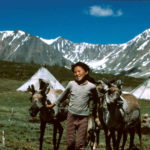We are here for our children – Survival International
On every continent, from the green depths of the Amazon basin to the icy reaches of the Arctic tundra, children raised in tribal communities are taught the skills and values that have ensured the survival of their peoples for generations.
In Malaysia, Penan children help to build homes from tree saplings and giant palm leaves; beneath the blue-green surface of the the Andaman Sea, Moken children learn to catch dugong, crab and sea-cucumber with long harpoons; in Mongolia, Tsaatan children are taught the ancient herding skills of their parents by corralling reindeer on the grasslands.
Tribal children are the inheritors of their territories, languages and unique ways of seeing the world; human repositories of their ancestors’ knowledge. As they are typically brought up in communities where the solidarity of the group is crucial to survival, children are taught that life is about ‘we’, not ‘I’, and balance with nature, not destruction.
Over recent decades, however, many tribal children have witnessed – and experienced – dispossession, disease and despair due to land theft, forced assimilation into mainstream societies and ‘development’ schemes. If their homelands continue to be threatened by destructive external forces; if their values and ways of life are not granted greater respect, the the future of tribal children will be as precarious as their childhoods have often been traumatic.
We are not here for ourselves, said Roy Sesana, a Gana Bushman from Botswana. We are here for our children, and the children of our grandchildren.
I want them to be able to see the stars, but not through industrial smoke, he said. I want them to drink the stream-water without falling ill, and wake to the call of the piha bird, instead of miners’ motor pumps.
Picture © Livia Monami/Survival



















